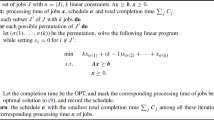Abstract
In a one-machine nonpreemptive scheduling problem, the feasible schedules may be defined by the vector of the corresponding job completion times. For given positive processing times, the associated simple scheduling polyhedronP is the convex hull of these feasible completion time vectors. The main result of this paper is a complete description of the minimal linear system definingP. We also give a complete, combinatorial description of the face lattice ofP, and a simple, O(n logn) separation algorithm. This algorithm has potential usefulness in cutting plane type algorithms for more difficult scheduling problems.
Similar content being viewed by others
References
A. Bachem and M. Grötschel, “Characterizations of adjacency of faces of polyhedra,”Mathematical Programming Study 14 (1981) 1–22.
A. Bachem and M. Grötschel, “New aspects of polyhedral theory,” in: B. Korte, ed.,Modern Applied Mathematics — Optimization and Operations Research (North-Holland, Amsterdam, 1982) pp. 51–106.
E. Balas, “On the facial structure of scheduling polyhedra,”Mathematical Programming Study 24 (1985) 179–218.
S.P. Bansal, “Single machine scheduling to minimize weighted sum of completion times with secondary criterion — a branch and bound approach,”European Journal of Operational Research 5 (1980) 177–181.
M. Barbut, ed.,Ordres Totaux Finis (Mouton, Paris, 1971).
M. Ben-Or, “Lower bounds for algebraic computation trees,”Proceedings 15th ACM Annual Symposium on Theory of Computing (May 1983) 80–86.
J.P. Benzécri, “Sur l'analyse des préférences,” in: M. Barbut, ed. (1971).
M. Dyer and L.A. Wolsey, “Formulating the single machine sequencing problem with release dates as a mixed integer program,”Discrete Applied Mathematics 26 (1990) 255–270.
J. Edmonds, “Submodular functions, matroids and certain polyhedra,” in: R. Guy, ed.,Combinatorial Structures and Their Applications (Gordon and Breach, New York, 1970) pp. 68–87.
R.E. Fox, “OPT—an answer for America,”Inventories and Production, Nov.–Dec. 1982, 10–19.
S. Fujishige, “Submodular systems and related topics,”Mathematical Programming Study 22 (1984) 113–131.
G. Grätzer,General Lattice Theory (Academic Press, New York, 1978).
M. Grötschel, L. Lovász and A. Schrijver, “The ellipsoid method and its consequences in combinatorial optimization,”Combinatorica 1 (1981) 169–197.
B. Grünbaum,Convex Polytopes (Wiley, London, 1967).
G. Th. Guilbaud and P. Rosenstiehl, “Analyse algébrique d'un scrutin,” in: M. Barbut, ed. (1971).
K. Jordan,Calculus of Finite Differences (Chelsea, New York, 1947).
G. Kreweras, “Représentation polyédrique des préordres complets finis,” in: M. Barbut, ed. (1971).
E.L. Lawler, “Recent results in the theory of machine scheduling,” in: A. Bachem, M. Grötschel and B. Korte, eds.,Mathematical Programming: The State of the Art — Bonn 1982 (Springer, Berlin, 1983) pp. 202–234.
E.L. Lawler, J.K. Lenstra and A.H.G. Rinnooy Kan, “Recent developments in deterministic sequencing and scheduling: a survey,” in: M.A.H. Dempster, J.K. Lenstra and A.H.G. Rinnooy Kan, eds.,Deterministic and Stochastic Scheduling (Reidel, Dordrecht, 1982) pp. 35–73.
E.L. Lawler, J.K. Lenstra, A.H.G. Rinnooy Kan and D.B. Shmoys, “Sequencing and scheduling: Algorithms and complexity,” Report BS-8909, Centre for Mathematics and Computer Science (Amsterdam, 1989).
J.K. Lenstra and A.H.G. Rinnooy Kan, “New directions in scheduling theory,”Operations Research Letters 2 (1984) 255–259.
J.K. Lenstra and A.H.G. Rinnooy Kan, “Scheduling theory since 1981: An annotated bibliography,” Report BW 188, Centre for Mathematics and Computer Science (Amsterdam, 1983).
L. Lovász, “Submodular functions and convexity,” in: A. Bachem, M. Grötschel and B. Korte, eds.,Mathematical Programming: The State of the Art — Bonn 1982 (Springer, Berlin, 1983) pp. 235–257.
J.-C. Picard and M. Queyranne, “Selected applications of minimum cuts in networks,”INFOR 20 (1982) 394–422.
M.E. Posner, “Minimizing weighted completion times with deadlines,”Operations Research 33 (1985) 562–574.
W.R. Pulleyblank, “Polyhedral Combinatorics,” in: A. Bachem, M. Grötschel and B. Korte, eds.,Mathematical Programming: The State of the Art — Bonn 1982 (Springer, Berlin, 1983) pp. 101–123.
F.P. Preparata and M.I. Shamos,Computational Geometry: An Introduction (Springer, New York, 1985).
M. Queyranne, “Structure of a nonpreemptive one-machine scheduling polyhedron,” TIMS/ORSA Joint National Meeting, New Orleans, May 1987.
M. Queyranne and Y. Wang, “Single-machine scheduling polyhedra with precedence constraints,”Mathematics of Operations Research 16 (1991) 1–20.
R.T. Rockafellar,Convex Analysis (Princeton University Press, Princeton, NJ, 1970).
W.E. Smith, “Various optimizers for single-stage production,”Naval Research and Logistics Quarterly 3 (1956) 59–66.
J. Stoer and C. Witzgall,Convexity and Optimization in Finite Dimensions I (Springer, Berlin, 1970).
P. Tseng, private communication (July 1986).
A.C. Yao and R.L. Rivest, “On the polyhedral decision problem,”SIAM Journal on Computing 9 (1980) 343–347.
Author information
Authors and Affiliations
Additional information
This research was supported in part by a grant from the Natural Sciences and Engineering Research Council of Canada, and by a Killam University Research Fellowship. The original version of this paper was completed when the author was visiting the Laboratoire d'Automatique et d'Analyse des Systèmes, Toulouse, France.
Rights and permissions
About this article
Cite this article
Queyranne, M. Structure of a simple scheduling polyhedron. Mathematical Programming 58, 263–285 (1993). https://doi.org/10.1007/BF01581271
Received:
Revised:
Issue Date:
DOI: https://doi.org/10.1007/BF01581271




